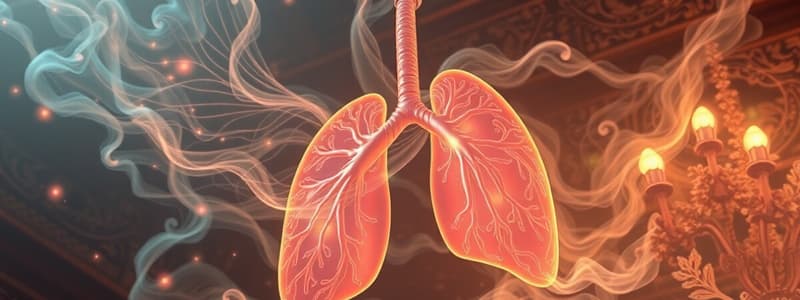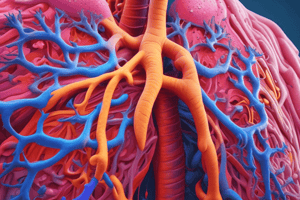Podcast
Questions and Answers
According to the equation given, air flow (F) is equal to the change in pressure (ΔP) divided by ______.
According to the equation given, air flow (F) is equal to the change in pressure (ΔP) divided by ______.
resistance (R)
Quiet inspiration involves the diaphragm and intercostal muscles, while quiet expiration is largely ______, relying on the lung's elasticity.
Quiet inspiration involves the diaphragm and intercostal muscles, while quiet expiration is largely ______, relying on the lung's elasticity.
passive
During forced inspiration, muscles such as the scalenes and ______ of the neck are utilized in addition to the diaphragm and intercostals.
During forced inspiration, muscles such as the scalenes and ______ of the neck are utilized in addition to the diaphragm and intercostals.
sternocleidomastoid
The diameter of the conducting zone airways influences resistance to airflow, and this is largely regulated by the ______ nervous system.
The diameter of the conducting zone airways influences resistance to airflow, and this is largely regulated by the ______ nervous system.
[Blank] innervation of the bronchioles causes dilation, decreasing resistance and increasing airflow.
[Blank] innervation of the bronchioles causes dilation, decreasing resistance and increasing airflow.
In contrast to sympathetic innervation, ______ innervation causes constriction of the bronchioles, increasing resistance and decreasing airflow.
In contrast to sympathetic innervation, ______ innervation causes constriction of the bronchioles, increasing resistance and decreasing airflow.
Besides autonomic control, resistance to airflow can also be influenced by mucus buildup, tumors, or ______ reactions in the airways.
Besides autonomic control, resistance to airflow can also be influenced by mucus buildup, tumors, or ______ reactions in the airways.
[Blank] compliance refers to the ability of the lungs to stretch and expand.
[Blank] compliance refers to the ability of the lungs to stretch and expand.
Lung compliance is quantified as change in ______ divided by change in pressure ($
rac{ΔV}{ΔP}$).
Lung compliance is quantified as change in ______ divided by change in pressure ($ rac{ΔV}{ΔP}$).
In the context of lung compliance, a lung with higher compliance is ______ to expand at any given pressure.
In the context of lung compliance, a lung with higher compliance is ______ to expand at any given pressure.
Pulmonary function data is collected from humans using a tool called a ______.
Pulmonary function data is collected from humans using a tool called a ______.
The volume of air inhaled or exhaled with each breath under resting conditions is known as ______ volume.
The volume of air inhaled or exhaled with each breath under resting conditions is known as ______ volume.
The amount of air that can be forcefully inhaled after a normal tidal volume inspiration is known as ______ reserve volume.
The amount of air that can be forcefully inhaled after a normal tidal volume inspiration is known as ______ reserve volume.
The amount of air remaining in the lungs after a forced expiration is known as ______ volume.
The amount of air remaining in the lungs after a forced expiration is known as ______ volume.
The maximum amount of air that can be expired after a maximum inspiratory effort is referred to as ______ capacity.
The maximum amount of air that can be expired after a maximum inspiratory effort is referred to as ______ capacity.
The volume of air remaining in the lungs after a normal tidal volume expiration is referred to as the ______ residual capacity.
The volume of air remaining in the lungs after a normal tidal volume expiration is referred to as the ______ residual capacity.
The maximum amount of air that can be inspired after a normal tidal volume expiration is referred to as ______ capacity.
The maximum amount of air that can be inspired after a normal tidal volume expiration is referred to as ______ capacity.
[Blank] dead space refers to the air in the conducting zones of the respiratory system that does not participate in gas exchange.
[Blank] dead space refers to the air in the conducting zones of the respiratory system that does not participate in gas exchange.
[Blank] dead space is defined as the air in the respiratory zone that does not contribute to gas exchange.
[Blank] dead space is defined as the air in the respiratory zone that does not contribute to gas exchange.
Flashcards
Air Flow Equation
Air Flow Equation
Airflow is directly proportional to the pressure difference and inversely proportional to resistance: F = ΔP/R
ΔP & Airflow
ΔP & Airflow
Changing the pressure gradient (ΔP) by contracting inspiratory or expiratory muscles alters airflow.
Quiet Inspiration Muscles
Quiet Inspiration Muscles
Diaphragm and intercostals contract.
Quiet Expiration
Quiet Expiration
Signup and view all the flashcards
Forced Inspiration Muscles
Forced Inspiration Muscles
Signup and view all the flashcards
Forced Expiration Muscles
Forced Expiration Muscles
Signup and view all the flashcards
Resistance to flow altered by...
Resistance to flow altered by...
Signup and view all the flashcards
Sympathetic Effect on Airway
Sympathetic Effect on Airway
Signup and view all the flashcards
Parasympathetic Effect on Airway
Parasympathetic Effect on Airway
Signup and view all the flashcards
Lung Compliance
Lung Compliance
Signup and view all the flashcards
Scarring / fibrosis
Scarring / fibrosis
Signup and view all the flashcards
Lung Volume Measurement Tool
Lung Volume Measurement Tool
Signup and view all the flashcards
Tidal Volume (TV)
Tidal Volume (TV)
Signup and view all the flashcards
Inspiratory Reserve Volume (IRV)
Inspiratory Reserve Volume (IRV)
Signup and view all the flashcards
Expiratory Reserve Volume (ERV)
Expiratory Reserve Volume (ERV)
Signup and view all the flashcards
Residual Volume (RV)
Residual Volume (RV)
Signup and view all the flashcards
Total Lung Capacity (TLC)
Total Lung Capacity (TLC)
Signup and view all the flashcards
Vital Capacity (VC)
Vital Capacity (VC)
Signup and view all the flashcards
Inspiratory Capacity (IC)
Inspiratory Capacity (IC)
Signup and view all the flashcards
Functional Residual Capacity (FRC)
Functional Residual Capacity (FRC)
Signup and view all the flashcards
What causes resistance of air into the lungs and how to alter it
What causes resistance of air into the lungs and how to alter it
Signup and view all the flashcards
ΔP
ΔP
Signup and view all the flashcards
R
R
Signup and view all the flashcards
Flow (F)
Flow (F)
Signup and view all the flashcards
Lung Compliance (CL)
Lung Compliance (CL)
Signup and view all the flashcards
Lung compliance Equation
Lung compliance Equation
Signup and view all the flashcards
How to change pressure between the atmosphere and the alveoli to allow more air to enter the lungs, including the specific muscles involved.
How to change pressure between the atmosphere and the alveoli to allow more air to enter the lungs, including the specific muscles involved.
Signup and view all the flashcards
what is used to gather pulmonary function data in humans
what is used to gather pulmonary function data in humans
Signup and view all the flashcards
8 variables obtained from a pulmonary function test
8 variables obtained from a pulmonary function test
Signup and view all the flashcards
Dead Space
Dead Space
Signup and view all the flashcards
Anatomical Dead Space
Anatomical Dead Space
Signup and view all the flashcards
Alveolar Dead Space
Alveolar Dead Space
Signup and view all the flashcards
Total dead Space
Total dead Space
Signup and view all the flashcards
Study Notes
Air Flow
- Air flow (F) is equal to the change in pressure (∆P) divided by resistance (R)
- ∆P represents the difference in pressure between atmosphere and alveoli; increased ∆P leads to increased air flow
- R represents resistance of airways; increased R leads to decreased air flow
- ∆P is altered by inspiratory and expiratory muscle contraction
- Quiet inspiration involves the diaphragm and intercostal muscles
- Quiet expiration happens passively due to the lung elasticity
- Forced inspiration uses scalenes & sternocleidomastoid neck muscles; this increases ∆P and air flow
- Forced expiration uses abdominal wall muscles (obliques); this increases ∆P and airflow
- Resistance to flow is altered by the diameter of conducting zone airways
- The autonomic nervous system largely regulates this resistance
- Sympathetic innervation causes bronchiole dilation, decreasing resistance and increasing airflow
- Parasympathetic innervation causes bronchiole constriction, increasing resistance and decreasing airflow
- Mucus buildup, tumors and allergic reactions can also influence resistance, increasing it and decreasing airflow
- Lung compliance (C₁) is the ability of the lungs to stretch and expand. It is calculated as the change in volume divided by the change in pressure
- Higher lung compliance results in easier lung expansion at any given pressure
- Scarring/fibrosis impairs lung compliance
Spirometer
- Lung volumes can be assessed using a spirometer
Lung Volumes and Capacities
- Tidal Volume (TV): 500 ml in both adult males and females, is the amount of air inhaled/exhaled with each breath under resting conditions
- Inspiratory Reserve Volume (IRV): 3100 ml in males and 1900 ml in females, is the amount of air that can be forcefully inhaled after a normal tidal volume inspiration
- Expiratory Reserve Volume (ERV): 1200 ml in males and 700 ml in females, is the amount of air that can be forcefully exhaled after a normal tidal volume expiration
- Residual Volume (RV): 1200 ml in males and 1100 ml in females, is the amount of air remaining in the lungs after a forced expiration
- Total Lung Capacity (TLC): 6000 ml in males and 4200 ml in females, is the maximum amount of air contained in the lungs after a maximum inspiratory effort; TLC = TV + IRV + ERV + RV
- Vital Capacity (VC): 4800 ml in males and 3100 ml in females, is the maximum amount of air that can be expired after a maximum inspiratory effort: VC = TV + IRV + ERV
- Inspiratory Capacity (IC): 3600 ml in males and 2400 ml in females, is the maximum amount of air that can be inspired after a normal tidal volume expiration: IC = TV + IRV
- Functional Residual Capacity (FRC): 2400 ml in males and 1800 ml in females, is the volume of air remaining in the lungs after a normal tidal volume expiration: FRC = ERV + RV
- Males typically have greater lung volumes than females
Dead Space
- Dead space is the volume of air that doesn't contribute to gas exchange
- Anatomical dead space is air in the conducting zones
- Alveolar dead space is air in the respiratory zone not contributing to gas exchange
- Total dead space is the sum of anatomical and alveolar dead space
Studying That Suits You
Use AI to generate personalized quizzes and flashcards to suit your learning preferences.




